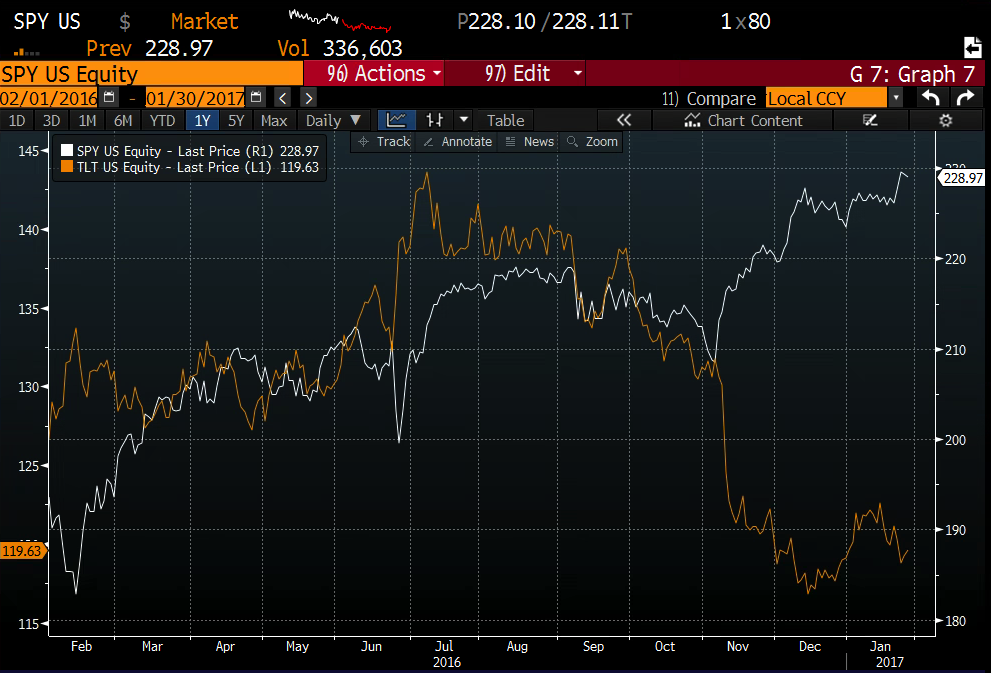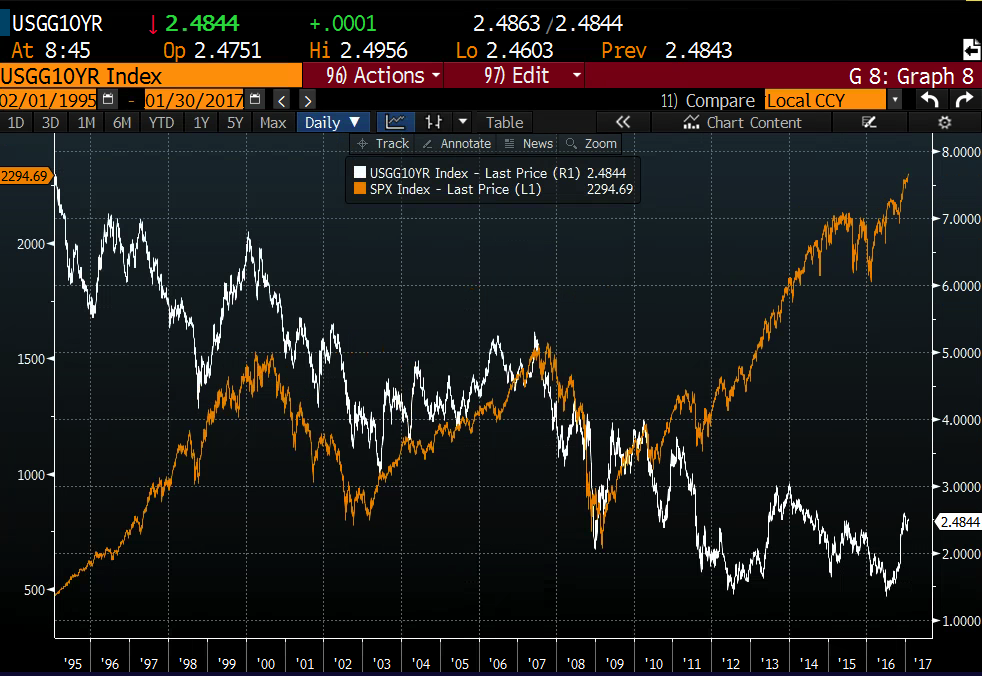Normally I’d say we’re in for a few fireworks in a week where equity markets in the U.S. are at all time highs, the volatility index (VIX) is near multi-year lows, we get earnings from three of the largest stocks on the planet (Apple, Amazon & Facebook), we have the first FOMC meeting of the year, the January Jobs reports due Friday, and all of this against the backdrop of the first month of a new President. But on the open this morning, the S&P 500 is only down slightly (-0.4%), and the VIX is up 8.5%, back only above 11. I suspect the VIX action is a combination of the Monday effect (vol gets marked down on Friday afternoon to make up for 2 days of no trading) but also a ton of uncertainty (and weekly protests in the streets) with potential trade wars and immigration policy (protectionism) a daily tape bomb. The VIX is a liquid product for institutional investors to grab near term protection and I imagine we may soon see the VIX start to tick up as trade policy uncertainty increases.
As it relates to earnings, the three stocks listed above make up $1.4 trillion in market capitalization, and the options market is implying only about a $65 billion market cap move for all combined, assuming they all don’t move in the same direction, and within the implied range (which is low for all) then the movement is likely to cancel each-other out. Two days after the Fed, the Jan jobs report is likely to be a non-event as the voting members likely have a good idea of what that report entails. Which leaves the Fed meeting. Currently Fed Fund futures are only pricing a 13.5% chance of a rate increase, and a 35% chance of a 25 bps increase at their March 15th meeting. The likelihood of the Fed surprising is low, but it would most certainly cause market palpitations as it is not the Fed’s MO to surprise on tightening, generally that is reserved for easing to achieve the maximum scramble effect, for buyers of risk assets, on the flip-side they like market participants to have some visibility for their actions and not induce selling panics.
As for implied movement, with the SPY’s $229 close on Friday, the SPY Feb 3rd weekly 229 straddle (the call premium + the put premium) went out offered at only $1.90, less than 1% of the etf price. That is completely mental. That is basically saying the implied movement in the S&P 500 for this coming week is less than 1% in either direction!
What’s even more surprising, is that with very low expectations for a rate move, the TLT, the iShares 20 year bond etf is implying greater movement than the S&P 500. Off of a $119.60 close on Friday, the Feb 3rd weekly 119.50 straddle went out offered at $1.85, or about 1.5% of the etf price, this for an etf that is down 17% from its 52 week highs made in July, vs the SPY which is up 10% since July and up 26% from its 52 week lows made last February.
It’s certainly a strange new world we live in. The 1yr chart below shows how Treasuries were tracking stocks until early November, which meant as stocks move higher the yield on the Treasuries moved lower. That seems like a fairly understandable relationship. But the break in November, where equity investors were not bothered by the rapid rise in rates following the election demonstrates a sort of risk taking we haven’t seen much of during the financial crisis recovery.

Shown another way, over a far longer period of time, since 1996, the age of “over exuberance”, the yield on the 10 year treasury has been on a long race the bottom, while equity bubbles thrice formed and bursted twice, resulting in 50% peak to trough declines:

Some will argue that the real bubble has been in Treasuries the entire time, causing the volatility in stocks over that time period. But we can agree that the period since 2008 is fairly special, and is a unique break from the prior decade.
Back to this week, maybe the options market has it right, maybe we get a whole heck of lot of nothing, one event canceling out the other. But sooner or later geo-political risk will not be ignored. We’ve written over and over again that the since the election, equity markets assumed all of the business friendly platform of the new administration, while assuming little or none of the protectionist and America First part. In just two weekends we’ve seen that that assumption is not true. We’ve already had a public spat and cancelled a summit with our 3rd largest trade partner, we have Silicon Valley up in arms over immigration policy, and aside from backing out of the Asian trade deal, we haven’t even gotten around to China yet.
Markets are notoriously bad at pricing in tail risk, but that’s a good thing if you’re an investor looking for protection.